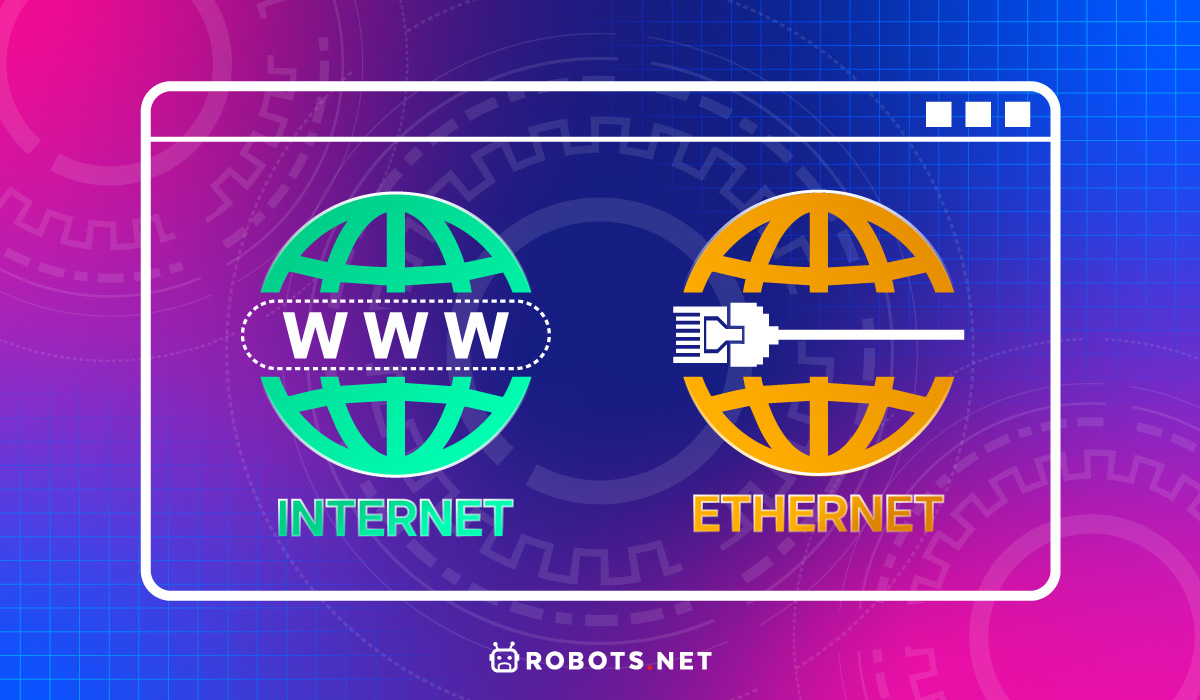What Is the Internet?
The internet is a network of interconnected computer systems that use the Internet Protocol Suite to communicate with each other. This protocol allows any device from a specific network to connect to other devices within other networks on a global scale. The network in which the internet runs is known simply as the worldwide network (WAN). The WAN consists of millions of computers and electronic devices from around the globe. The internet offers a long list of potential use cases, starting with communication via electronic mail or social media. It’s also a great source of information on anything and everything, especially with millions of websites offering information for free. There are different ways to connect to the internet, including a dial-up connection, broadband, or a wireless connection.
What Is the Ethernet?
The ethernet is an older type of network connection that allows devices that belong to the same network to communicate with each other via a local area network (LAN). The technology is useful for connecting devices within a smaller network, allowing them to share data amongst themselves. Unlike the internet, which connects devices to a larger, global network (WAN), ethernet only ever allows devices that run on the same communications line or wireless link to connect. Ethernet-based connections often require physical or cabled connections between devices to allow for the passage of data. More specifically, you would normally have an ethernet cable connected to both devices to move data to and from them. The cables transport the data physically instead of wirelessly, as wireless internet tends to do. The inherently exclusive nature of ethernet networks poses a variety of advantages compared to the internet. For starters, ethernet networks tend to provide faster speeds, and they are also generally more reliable than wireless networks. It’s also more secure than wireless internet because it requires a cabled connection and can only be had within a specific area.
What Is the Difference Between Internet and Ethernet?
Internet and ethernet are frequently found together or in alternating fashion in everyday conversation. However, these terms do have significant distinctions. These distinctions between the two network types serve a practical purpose in covering most potential use cases. In this way, the two network types can function in a complementary manner, covering different use cases each. That said, the key differences between the two network types are worth looking at, and we present them to you here.
1. Network Range
The first and perhaps most glaring difference between the internet and ethernet relates to the range of connectivity. The internet runs on a special protocol called the Transmission Control Protocol (TCP) or Internet Protocol. With this protocol in place, internet users can send and receive data wirelessly, regardless of location. In other words, there is no apparent physical limitation to the network range for the internet. Unlike internet-based connections, ethernet-based connections are only able to cover devices within a small geographical area known as the local area network (LAN). A typical Ethernet connection will only be able to connect computers within a distance of approximately 10 kilometers. This makes it ideal for use in schools and workplaces within grounds of a few kilometers at most. Given the geographical limitations of the LAN network, it only follows that multiple LAN networks exist within any given area. In contrast, a thousand smaller networks comprise the internet, forming a singular, massive, and global network.
2. Speed
Speed is one of the more critical factors to consider in any connectivity. The latter almost always has the upper hand between wireless internet and an ethernet-based connection. Ethernet cables allow for direct and instantaneous data transmission, which is even more evident with fiber optic cables. Direct data transmission eliminates the risk of interference from devices outside the network, promoting faster speeds. Another factor that plays into an internet connection’s quality is the physical distance between the device and the routing point. That being said, wireless-based connections tend to falter the further the device is from the router. When it comes to the ethernet, on the other hand, it doesn’t matter how far your device/s are from the router. For as long as your device/s are plugged into the modem, they should be able to access the network. Of course, like with most things, you don’t always get what you pay for, and the same goes for internet speed. If, at one point, you find yourself asking, “why is my internet so slow?” then take that as a sign that you need to check your internet speeds. Luckily, there are a variety of things you can do, most of which are listed in this complete guide on how to check your internet speed. Part of this process is using special or free software like Speedtest by Ookla. If the speed tests confirm your suspicions, you should immediately take steps to increase your internet speed.
3. Mode of Transmission
Another factor that plays into the transmission speed relates to each network type’s particular mode of transmission. Ethernet-based connections can transmit data in full duplex mode, allowing two parties to receive and transmit data simultaneously. In contrast, wireless internet can only transmit data in half-duplex mode. To clarify, a half-duplex mode is when data can be sent by two parties in both directions but not simultaneously.
4. Security
Because of the small scope of the ethernet compared to the internet, it is also much easier to secure compared to the internet. As we’ve mentioned, the internet passes data wirelessly via radio signals, which makes it vulnerable to hacking and infiltration by forces watching the network. In other words, anyone with the right set of skills can potentially hack into your network and steal your data, including your Wi-Fi password. Ethernet-type connections are generally free from those risks since only authorized devices are allowed into the network. Not to mention, the network will only accept devices with special permissions. In other words, third parties and other devices outside the network will not be able to enter the network.
5. Reliability
Reliability is a measure of how consistently a network can perform. Between the internet and ethernet, the latter appears more reliable over time, thanks to its use of cables. As an analogy, an Ethernet connection is a lot like using a wired telephone instead of a cell phone. Instead of relying on wireless signals to communicate, an Ethernet setup will transport data directly and physically via cables. The direct connection reduces the likelihood of the data getting lost or degraded along the way. On top of that, you will also not have to worry about signals from other devices interfering with your transmissions. Unless your Ethernet cables physically break, there isn’t much that can disrupt your connection.
6. Number of Devices
Another factor to take into consideration is the number of devices that can connect to a particular network, of which there are differences between ethernet and the internet. One of the main advantages of wireless internet is that it can theoretically support as many devices as you have. However, realistically speaking, having a large number of devices connected to the same network may have a detrimental effect on connection speeds and reliability. This has to do with the fact that Ethernet-based connections operate on a strictly wired setup. Additionally, most routers have a limited number of Ethernet ports available. A standard router, for example, normally sports approximately four Ethernet ports. Although, of course, you can always use extenders or switches to increase the number of devices plugged into the network.
When Should You Use Ethernet or Internet?
Now that we have a better picture of how each connection type works as well as the advantages of each, it only makes sense to explore the intended use cases for each network connection type. Which network type is appropriate for which instances, and can they be used at the same time? Let’s find out.
When to Use the Internet Exclusively
Between the internet and the ethernet, there is no question that the former is the more popular option. It is accessible everywhere with a router, and you don’t need Ethernet cables to get through. But even then, there are particular instances in which using the internet is more advantageous than the alternative. That being said, pay attention to the following circumstances in which you’re better off using it:
Anytime you are outdoors and need to rely on mobile data Whenever you choose to access a public wireless internet Need to send information to a different location When you prefer a more stable connection over security Are gaming with people who are in different locations
When to Use the Ethernet Exclusively
As mentioned, the internet has vastly increased in popularity over the years, to the point where “going online” has become synonymous with using the internet. That being said, we’ve reached the point where most people are no longer aware of what ethernet even is. But while the internet may be the typical go-to for people, there are instances when you would be better off using the ethernet. These instances include the following:
Need to download or upload a large file and quickly When you are playing multiplayer games with people who are present in the same room as you Need to send data containing private, highly confidential, or personal information Whenever the wireless internet connection isn’t working
When to Use the Internet and Ethernet Simultaneously
We’ve already delineated the different use cases for each network type. However, one question remains: is it possible to use the internet and ethernet simultaneously? The quick answer is yes; you can use both the internet and ethernet simultaneously. Most wireless routers are outfitted with a handful of Ethernet ports for plugging in your devices directly via Ethernet cables. A few routers (though not all) are also able to accommodate a mixture of wired and wireless devices. That being said, you should be able to connect your devices to the internet and ethernet simultaneously. However, it’s important to note that this connection only works when you need to send data to other devices within your LAN while also having other businesses to tend to over the internet. It also applies to situations where you have fewer ethernet ports than devices you need to connect. It’s important to note that while you can use both the internet and ethernet simultaneously, the setup will only work if the Wi-Fi and ethernet networks and routers function independently. This is due to the inherent risk that the networks interfere with each other, leading to poor connectivity and stability. That being said, choosing one might be better than using both simultaneously. It may be tempting to think that simultaneously accessing the internet and ethernet may fix a slow internet. Unfortunately, it most likely will not work. This is because internet signals come from the same source (router). Additionally, they have little to do with the medium in which they are transmitted. In other words, the maximum speeds of your router are likely a better determinant of internet speeds than the type of network that you choose.
Final Thoughts on the Difference Between Internet and Ethernet
And that concludes our analysis of the individual characteristics, similarities, and differences between the internet and ethernet. Both network types allow a way for computers to connect, although they run on entirely different protocols and guidelines. In hindsight, internet and Ethernet-type connections appear to complement each other in more ways than they compete with each other. That being said, you need to understand the distinctions between these two network types to be able to determine which one to use for any particular use case. That way, you can maximize the resources available to you and send and receive data most efficiently.






